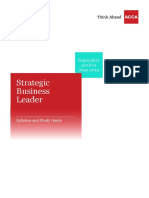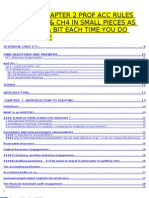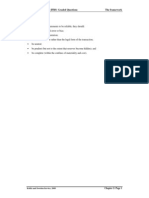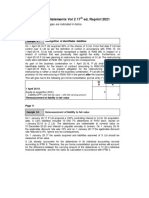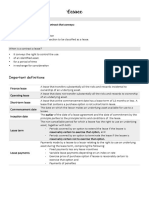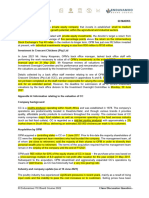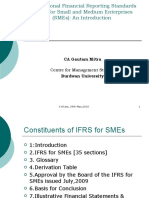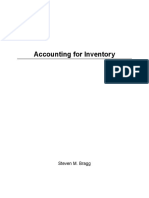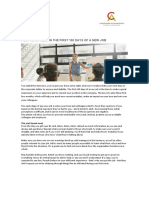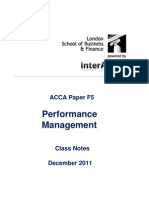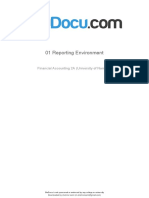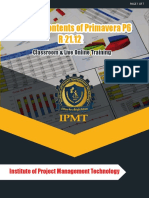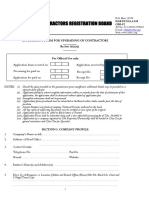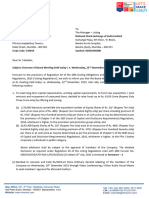Tutorial 1 Homework Solutions
Uploaded by
MongeziTutorial 1 Homework Solutions
Uploaded by
MongeziUniversity of Kwa-Zulu Natal
Accounting 211
2023
Tutorial week 1
Homework Solutions
Financial reporting environment
The Conceptual Framework for financial reporting
Solutions to GAAP : Graded Questions Financial reporting environment
Solution 1.1
a.
The International Accounting Standards Board is responsible for:
a) Providing guidance on issues arising from the application and interpretation of IFRS.
b) Dealing with issues arising from an IFRS, which are not specifically covered by the IFRS.
c) The development and publication of IFRSs and approving interpretations of IFRSs
developed by the IFRS Interpretations Committee.
d) Monitoring and governing the activities of the IFRS Foundation.
b.
A draft accounting standard published by the International Accounting Standards Board
(IASB) is referred to as:
a) A standard
b) A discussion paper
c) A working paper
d) An exposure draft
e) An interpretation
© Service & Kolitz, 2022 - 2023 Chapter 1: Page 1
Solutions to GAAP : Graded Questions Financial reporting environment
Solution 1.2
a) The meaning of the term ‘IFRS’
The term 'International Financial Reporting Standards' (IFRS) has both a narrow and a broad
meaning.
Narrowly, IFRS refers to the numbered series of pronouncements that the IASB is issuing, such
as IFRS 15 Revenue or IFRS 16 Leases. This is distinct from the International Accounting
Standards (IASs) series issued by its predecessor, the International Accounting Standards
Committee (IASC).
More broadly, IFRS refers to the entire body of IASB pronouncements, including standards and
interpretations approved by the IASB and IASs and SIC interpretations approved by the
predecessor International Accounting Standards Committee (IASC).
b) The meaning of the term ‘standards’
Standards contain the principles applied by accountants in the preparation of financial
statements.
These standards are developed and issued by the International Accounting Standards Board
(IASB). However, the development process follows strict due process procedures that require
much collaboration with national standard-setters from around the world and other interested
parties.
c) The meaning of the term ‘interpretations’
As standards are applied in practice, issues often arise that need clarification by the IASB.
Where an explanation is required, the IASB issues a document called an interpretation.
Interpretations are given the same authority as the standards. Thus, if a standard comes with an
interpretation, this standard must be read together with its interpretation.
Although interpretations are issued by the IASB, they are actually developed by the IASB’s
Interpretations Committee. As with the development of standards, the development of
interpretations follows strict due process procedures that require much collaboration with
national standard-setters from around the world and other interested parties.
Since the IAS Board adopted all the work done by the previous IAS Committee, some
interpretations are prefixed with SIC and some are prefixed with IFRIC:
• The old IASC prefixed their interpretations with SIC, being the acronym for the committee
responsible for their development: Standing Interpretations Committee.
• The new IASB prefixes interpretations with IFRIC, being the acronym for the committee that
develops them: International Financial Reporting Interpretations Committee.
© Service & Kolitz, 2022 - 2023 Chapter 1: Page 2
Solutions to GAAP : Graded Questions Financial reporting environment
Solution 1.3
a) What does compliance with IFRS mean?
To be able to state in the financial report that the financial statements comply with IFRS, the
entity must have complied with both the
• Standards, whether prefixed with IAS or IFRS; and
• Interpretations, whether prefixed with SIC or IFRIC.
When a set of financial statements is prepared in terms of IFRSs, a declaration of this
compliance must be included in the notes to the financial statements (IAS1.16).
b) Why would a company comply with IFRS?
There is no international body forcing compliance with IFRSs. A country’s specific national
legislation may
• require compliance with IFRSs
• neither requires nor disallows compliance with IFRS
• disallow compliance.
If national legislation requires compliance for certain entities (for example, listed companies),
it is because of the legislation that a company would comply with IFRS. However, in situations
where compliance is neither required and nor disallowed, compliance with IFRS gives
credibility to the financial statements and makes them understandable to foreigners, thus
encouraging foreign investment.
For many years, South Africa’s legislation did not require compliance with IFRSs. Despite this,
the increased credibility gained from complying with IFRSs led many South African companies
to adopt IFRSs. However, South Africa’s Companies Act now requires all listed companies to
comply with IFRSs while other companies may choose to comply.
Since compliance with IFRSs lends international credibility to the financial statements, to be
able to make such a statement is desirable to most entities.
c) The extent of compliance with IFRS around the world
The term ‘International Financial Reporting Standards’ can be a bit misleading at present since
not all countries use them. In other words, these standards are technically not ‘international’
until all countries require the use thereof. The situation is currently as follows:
• At least 1381 participating countries (as at 30 March 20171) already either permit or require
the use of IFRSs. Examples include South Africa, United Kingdom and all other member
states of the European Union, Australia, New Zealand, Canada, Saudi Arabia etc.2
• There are some countries that actually do not permit the use of IFRSs. Examples of some of these
include: Cuba, Indonesia, Iran, Mali, Senegal and Vietnam.2
• Some countries permit the use of IFRSs for some companies and disallow for others. For
example, the United States does not permit the use of IFRS by their domestic listed
companies but permits the use of IFRS by their domestic unlisted companies. 2
1. http://www.ifrs.org/use-around-the-world/use-of-ifrs-standards-by-jurisdiction/#analysis
2. https://www.iasplus.com/en/resources/ifrs-topics/use-of-ifrs
Some countries have adopted the IFRSs word-for-word as their own national GAAP. Others have
adopted IFRSs but with certain modifications that they consider necessary due to reasons that are
peculiar to that jurisdiction and which they thus believe have not been dealt with in the IFRSs.
© Service & Kolitz, 2022 - 2023 Chapter 1: Page 3
Solutions to GAAP : Graded Questions Financial reporting environment
Solution 1.3 continued
There are other countries, however, that are not adopting the IFRSs but are choosing to converge their
national GAAP with the IFRSs instead. Examples include the United States of America, China and
India.
Thus, some countries have adopted IFRS but with modifications and some countries use their own
national GAAP which they argue has been or is being converged with IFRSs. However, research has
found that the difference between using pure IFRSs (i.e. pure adoption) versus using modified IFRSs
or a national GAAP that has been converged with IFRSs can be significant, despite claims to the
contrary.
Full details can be found at
http://www.ifrs.org/use-around-the-world/use-of-ifrs-standards-by-jurisdiction/#analysis
© Service & Kolitz, 2022 - 2023 Chapter 1: Page 4
Solutions to GAAP : Graded Questions Financial reporting environment
Solution 1.4
Modern economies rely on cross-border transactions and the free flow of international
capital. More than a third of all financial transactions occur across borders, and that number is
expected to grow.
Investors seek diversification and investment opportunities across the world, while companies
raise capital, undertake transactions or have international operations and subsidiaries in
multiple countries.
In the past, such cross-border activities were complicated by different countries maintaining
their own sets of national accounting standards. This patchwork of accounting requirements
often added cost, complexity and ultimately risk both to companies preparing financial
statements and investors and others using those financial statements to make economic
decisions.
Applying national accounting standards meant amounts reported in financial statements might
be calculated on a different basis. Unpicking this complexity involved studying the minutiae of
national accounting standards, because even a small difference in requirements could have a
major impact on a company’s reported financial performance and financial position—for
example, a company may recognise profits under one set of national accounting standards and
losses under another.
IFRS Standards address this challenge by providing a high quality, internationally recognised
set of accounting standards that bring transparency, accountability and efficiency to financial
markets around the world.
IFRS Standards bring transparency by enhancing the international comparability and quality
of financial information, enabling investors and other market participants to make informed
economic decisions.
IFRS Standards strengthen accountability by reducing the information gap between the
providers of capital and the people to whom they have entrusted their money. Our Standards
provide information that is needed to hold management to account. As a source of globally
comparable information, IFRS Standards are also of vital importance to regulators around the
world.
And IFRS Standards contribute to economic efficiency by helping investors to identify
opportunities and risks across the world, thus improving capital allocation. For businesses, the
use of a single, trusted accounting language lowers the cost of capital and reduces international
reporting costs.
Solution adapted from
https://www.ifrs.org/use-around-the-world/why-global-accounting-standards/
© Service & Kolitz, 2022 - 2023 Chapter 1: Page 5
Solutions to GAAP : Graded Questions Financial reporting environment
Solution 1.5
Agenda consultation
• Every five years, the IASB conducts a comprehensive review to set its priorities and
develop its project work plan
• Other topics can also be added to its work plan between agenda consultations arising from,
for example, a post-implementation reviews of a standard.
Research programme
• Most projects begin with research that explore the issues, identify possible solutions and
decide whether standard-setting is required. Before proposing the development of a new
standard, the IASB normally issues a discussion paper to seek public comment.
• If feedback provides evidence that an accounting problem exists and the problem is
sufficiently important to warrant changing an existing Standard or issuing a new one (and a
practical solution can be found), work begins on
Standard-setting programme
• If the IASB decides to amend an existing standard or issue a new one, the proposals are
published in an exposure draft for public consultation. To gather additional evidence,
members of the Board and IFRS Foundation technical staff consult with a range
of stakeholders from all over the world.
• All feedback is analysed and the exposure draft is refined before a new standard, or an
amendment to an existing standard, is issued.
Maintenance programme
• The IASB supports implementation of the standards and also maintains them.
• This includes consulting on the implementation of a new or amended standard to identify
any implementation problems that may need to be addressed.
• If issues arise, the IFRS Interpretations Committee may decide to create an IFRIC
Interpretation of the Standard or recommend a narrow-scope amendment. Such
amendments follow the Board's normal due process.
© Service & Kolitz, 2022 - 2023 Chapter 1: Page 6
Solutions to GAAP : Graded Questions Financial reporting environment
Solution 1.6
a) Objectives of IFRS Foundation
• to develop, in the public interest, a single set of high quality, understandable,
enforceable and globally accepted financial reporting standards based upon clearly
articulated principles. These standards should require high quality, transparent and
comparable information in financial statements and other financial reporting to help
investors, other participants in the world’s capital markets and other users of
financial information make economic decisions.
• to promote the use and rigorous application of those standards.
• to promote and facilitate adoption of International Financial Reporting Standards
(IFRSs), being the standards and interpretations issued by the IASB, through the
convergence of national accounting standards and IFRSs
The IFRS Foundation takes account, as appropriate, the needs of a range of sizes and types of
entities in diverse economic settings.
b) Role in standard setting process
• IFRS Foundation
The IFRS Foundation exists as the legal entity under which the IASB operates. It is described
as ‘an independent, not-for-profit private organisation working in the public interest’.
• The IASB
• The International Accounting Standards Board (IASB) is an independent group of
experts with an appropriate mix of recent practical experience in setting accounting
standards, in preparing, auditing, or using financial reports, and in accounting
education. Broad geographical diversity is also required.
• Board members are responsible for the development and publication of IFRS
Standards, including the IFRS for SMEs Standard.
• The IASB is also responsible for approving Interpretations of IFRS Standards as
developed by the IFRS Interpretations Committee (formerly IFRIC).
• Members of the IASB are appointed by the IFRS Foundation Trustees through an open
and rigorous process that includes advertising vacancies and consulting relevant
organisations.
• The IFRS Foundation Trustees
• The trustees are responsible for the governance and oversight of the International
Accounting Standards Board
• The trustees are not involved in any technical matters relating to IFRS Standards. This
responsibility rests solely with the Board.
• The Trustees are accountable to the Monitoring Board, a body of publicly accountable
market authorities.
© Service & Kolitz, 2022 - 2023 Chapter 1: Page 7
Solutions to GAAP : Graded Questions Financial reporting environment
Solution 1.6 continued . . .
• The IFRS Interpretations Committee
• The IFRS Interpretations Committee (Interpretations Committee) is the interpretative
body of the International Accounting Standards Board. The Interpretations Committee
works with the IASB in supporting the application of IFRS Standards.
• The Interpretations Committee responds to questions about the application of the
Standards and does other work at the request of the Board.
• The Interpretations Committee comprises 14 voting members, appointed by the
Trustees of the IFRS Foundation. The members provide the best available technical
expertise and diversity of international business and market experience relating to the
application of IFRS Standards
• The IFRS Foundation Monitoring Board
• The Monitoring Board ensures that the IFRS Foundation and the IASB’s decision-
making are independent. According to both the Constitution and the Monitoring
Board’s Charter, the Monitoring Board's main responsibilities include:
• ensuring the Trustees discharge their duties as defined by the Constitution;
• approving the appointment or reappointment of Trustees;
• meeting with the Trustees at least once a year (or more often if appropriate). 1
© Service & Kolitz, 2022 - 2023 Chapter 1: Page 8
Solutions to GAAP : Graded Questions Financial reporting environment
Solution 1.7
Are par value shares permissible in terms of the Companies Act?
Companies may not authorise any new par value shares (also known as shares having a nominal
value) on or after the effective date (1 May 2011). However, for pre-existing authorised par
value shares the following applies:
• Companies that had authorised par value shares that were already in issue on the effective
date may leave these par value shares in issue, although the company also has the option of
converting them instead. See Companies Act Schedule 5 S6(2)
• Companies that had authorised par value shares in existence on the effective date that had
not yet been issued by this date, must apply the following rules:
- If none of the authorised par value shares have yet been issued or some have been issued
but all of these have subsequently been re-acquired, then none of these unissued par
value shares may be issued – these shares will first need to be converted into shares of
no par value. See Companies Regulations 31(3)
- If some of the authorised par value shares have been issued with some still remaining
unissued, these remaining unissued par value shares may still be issued...but only until
such time as the company chooses to convert these shares into no par value shares and
publishes a proposal to this effect. See Companies Regulations 31(5)
Close Corporations
New Close Corporations (CCs) may not be created after the effective date (1 May 2011).
However, CCs that were already in existence on this effective date may either:
• continue as a CC; or
• convert into a company.
Existing CC’s were given the option to continue as CCs instead of being forced to convert to
companies due to logistical reasons. (There are roughly 2 million CCs in South Africa
compared to roughly only 400 000 companies).
CCs that choose not to convert into a company must note that the Close Corporations Act has
been amended such that CCs will have to comply with most sections of the Companies Act and
related Regulations as if the CC were a company. For example, CCs will be subject to the same
criteria as companies when deciding what reporting standards to use and whether an audit or
independent review is required.
© Service & Kolitz, 2022 - 2023 Chapter 1: Page 9
Solutions to GAAP : Graded Questions Financial reporting environment
Solution 1.8
a) Differential reporting refers to the various levels of compliance which apply depending on
the category of company.
The purpose of differential reporting is to allow smaller and less sophisticated companies
to produce financial statements using a simpler set of reporting standards than the
international standards that larger companies must comply with. The concept of differential
reporting was borne out of the acceptance that the content of the financial statements should
be driven by the needs of users. In other words:
• very small entities, for example, would need less complex financial statements because
the users of the financial statements are generally involved in the management of the
entity; whereas
• very large entities, for example, have thousands of shareholders who have no
involvement in the running of the business and thus need more information to be
included in the financial statements in order to assist in their decisions.
b) An SME is distinguished from another entity is that it has no public accountability but yet
it still produces general purpose financial statements for external users.
The IFRS for SMEs explains that an entity has public accountability if:
• its debt or equity instruments are publicly traded; or
• one of its primary businesses is to hold assets in a fiduciary capacity (i.e. having the
legal authority and duty to make financial decisions) for a broad group of outsiders, or
example banks, credit unions, insurance companies, securities brokers/dealers, mutual
funds and investment banks
c) Although prepared on IFRS foundations, the IFRS for SMEs is a stand–alone framework
which is separate from all other IFRSs. The IFRS for SMEs will be available to be used by
certain qualifying entities (i.e. some entities will have to apply full IFRSs and other
qualifying entities may apply IFRS for SMEs instead). The IFRS for SMEs provides the
following benefits:
• provides disclosure relief (less detail needs to be disclosed in financial statements);
• simplifies many recognition and measurement criteria;
• removes choices for accounting treatments; and
• eliminates certain topics that are generally not relevant to SMEs
© Service & Kolitz, 2022 - 2023 Chapter 1: Page 10
Solutions to GAAP : Graded Questions Financial reporting environment
Solution 1.9
For many years, South Africa had both:
• a national standard-setter (called the Accounting Practices Board: APB ) which published
SA accounting standards (SA GAAP); and
• a monitoring panel (originally called the GAAP Monitoring Panel: GMP, but since renamed
the Financial Reporting Investigation Panel: FRIP) which ensured that listed companies
complied with accounting standards.
However the previous Companies Act did not require companies to comply with these
standards.
The Companies Act of 2008 requires compliance with financial reporting standards (FRSs). It
further states that any person involved in the preparation, approval, dissemination or publication
of any financial statements will be guilty of an offence if those financial statements do not
comply with IFRSs when they should comply. (S29)
Furthermore, the related Companies Act Regulations 2011 stipulate what specific standards
constitute these so-called financial reporting standards.
The Regulations (S27) refers to two principal kinds of financial reporting standards (FRSs) to
be used by companies, depending on the nature of the company:
• IFRSs: International Financial Reporting Standards;
• IFRS for SMEs: IFRSs for Small and Medium-sized Entities;
This means that, with the introduction of the new Companies Act, certain companies are now
legally required to comply with IFRSs. Furthermore, by requiring other companies to choose
between using either IFRS or IFRS for SMEs, the new Companies Act has effectively provided
legal backing for what is referred to as differential reporting in South Africa.
Where the FRSs must be IFRSs, the Financial Reporting Investigation Panel (FRIP) (a joint initiative
between the SA Institute of Chartered Accountants and the JSE Securities Exchange), investigates and
advises the JSE on alleged cases of non-compliance with IFRSs. The FRIP will also pro-actively
review the financial reporting of all companies listed on the JSE at least once every 5 years.
© Service & Kolitz, 2022 - 2023 Chapter 1: Page 11
Solutions to GAAP : Graded Questions Financial reporting environment
Solution 1.10
The Constitution of the IFRS Foundation refers only to the term ‘convergence’. Ultimately,
however, the purpose of both harmonisation and convergence is to create a single set of high
quality, global GAAP to be adopted world-wide.
The process of harmonisation involves the IASB and national standard setters meeting to
analyse and compare practices around the world in order to
• identify differences and to try and eliminate them
• help guide the development of international standards
Essentially, the purpose of convergence is to try to reduce the differences between the IFRSs
and the standards of that specific country. It involves discussion and collaboration
between that country’s standard-setters and the IASB in order to assess the differences and
reach an agreement on how to minimise them.
The IFRS Foundation’s constitution clarifies that the ultimate objective is adoption of IFRSs,
and that convergence is simply a means to achieve adoption. Convergence is simply a stepping
stone due to the resistance from some countries to adopting IFRSs.
For further interesting reading, see the speech given by the IASB chairman, Andreas Barckow
at the AICPA and CIMA Conference on Current SEC and PCAOB Developments on
7 December 2021 in Washington:
https://www.ifrs.org/news-and-events/news/2021/12/connectivity-core-work-and-
convergence/
© Service & Kolitz, 2022 - 2023 Chapter 1: Page 12
Solutions to GAAP : Graded Questions The conceptual framework
Solution 2.1
a.
The Conceptual Framework is an IFRS and can override any specific IFRS.
a) True
b) False
The Conceptual Framework is not a Standard. Nothing in the Conceptual Framework overrides any
Standard or any requirement in a Standard.
(CF, SP1.2)
b.
Considering the fundamental qualitative characteristics of useful information in accordance
with the IASB’s Conceptual Framework
1. A faithful representation of an irrelevant information would not help users make good
decisions.
2. An unfaithful representation of relevant information would not help users make good
decisions.
a) 1 is true and 2 is false
b) 1 is false and 2 is true
c) 1 and 2 are both true
d) 1 and 2 are both false
Neither a faithful representation of an irrelevant phenomenon nor an unfaithful representation of a
relevant phenomenon helps users make good decisions.
(CF, 1.20)
c.
According to the Conceptual Framework definition of an asset
1. An asset is considered as a physical object
2. An asset is considered as a set of rights
a) 1 only is true
b) 2 only is true
c) 1 and 2 are both true
d) 1 and 2 are both false
In many cases, the set of rights arising from legal ownership of a physical object is accounted for as a
single asset. Conceptually, the economic resource is the set of rights, not the physical object.
Nevertheless, describing the set of rights as the physical object will often provide a faithful
representation of those rights in the most concise and understandable way.
(CF, 4.12)
© Service & Kolitz , 2022 - 2023 Chapter 2: Page 1
Solutions to GAAP : Graded Questions The conceptual framework
d.
A liability is defined in the IASB Conceptual Framework as
a) A present obligation arising from a future event, the settlement of which is expected to
result in an outflow of future economic benefits from the entity.
b) A present obligation of the entity to transfer an economic resource as a result of past
events.
c) A future obligation arising from a past event, the settlement of which is expected to result
in an outflow of future economic benefits from the entity.
d) A present obligation arising from a past event, the settlement of which is expected to
result in an inflow of future economic benefits to the entity.
e) A future obligation of the entity to transfer an economic resource as a result of past
events.
(CF, 4.27)
e.
According to The Conceptual Framework, prudence
1. is the exercise of caution when making decisions under conditions of uncertainty
2. means that assets and income are not overstated and that liabilities and expenses are not
understated
3. does not allow for the understatement of assets or income or the overstatement of
liabilities or expenses
a) 1 only is correct
b) 1 and 2 are correct
c) 1 and 3 are correct
d) 1, 2 and 3 are correct
e) 2 and 3 are correct
Prudence is the exercise of caution when making judgements under conditions of uncertainty. The
exercise of prudence means that assets and income are not overstated and liabilities and expenses are
not understated. Equally, the exercise of prudence does not allow for the understatement of assets or
income or the overstatement of liabilities or expenses. Such misstatements can lead to the
overstatement or understatement of income or expenses in future periods.
(CF, 2.16)
© Service & Kolitz , 2022 - 2023 Chapter 2: Page 2
Solutions to GAAP : Graded Questions The conceptual framework
Solution 2.2
The objective of financial reporting is to provide financial information that is useful to users
in making decisions relating to providing resources to the entity.
To make these decisions, users need to assess
• the prospects for future net cash flows, and
• management’s stewardship of the entity’s economic resources.
To make these assessments, users need information about
• the entity’s economic resources, claims against the entity and changes in both
• how efficiently and effectively management has discharged its responsibilities to use the
entity’s resources.
Both types of information are needed to provide useful information for making decisions
about providing resources to the entity, and therefore to achieve the objective of financial
reporting.
© Service & Kolitz , 2022 - 2023 Chapter 2: Page 3
Solutions to GAAP : Graded Questions The conceptual framework
Solution 2.3
Prudence
Prudence supports neutrality of information which is the exercise of caution when making
judgements under conditions of uncertainty. Because neutrality means ‘depiction without
bias’, prudence is not biased towards recognising fewer assets and more liabilities – both
assets and liabilities should not be overstated nor understated.
Substance over form
In order for information to faithfully represent a transaction, that information must reflect the
substance of the transaction and not merely its legal form.
Measurement uncertainty
Measurement uncertainty is a factor that can affect faithful representation. However, it does
not necessarily mean that a high level of measurement uncertainty prevents an item from
providing useful information. Estimates are an essential part of financial reporting that do not
undermine the usefulness of the reported information.
There is a trade-off between measurement uncertainty and relevance. For example, the most
relevant information about a transaction may have a high level of measurement uncertainty
and therefore it does not faithfully represent the transaction.
© Service & Kolitz , 2022 - 2023 Chapter 2: Page 4
Solutions to GAAP : Graded Questions The conceptual framework
Solution 2.4
Financial statements
• Financial statements are a particular form of financial report that provides information
about the reporting entity’s assets, liabilities, equity, income and expenses.
• Financial statements are prepared from the perspective of the entity as a whole, rather
than from the perspective of any group of users.
• The financial statements are prepared from the assumption that the reporting entity is a
going concern.
Reporting entity
• A reporting entity is an entity that is required, or chooses, to prepare financial statements.
Examples include an incorporated company and a group comprising a parent and its
subsidiaries.
• It is not necessarily a legal entity.
© Service & Kolitz , 2022 - 2023 Chapter 2: Page 5
Solutions to GAAP : Graded Questions The conceptual framework
Solution 2.5
Asset
• The focus of the definitions of an asset is on the existence of a right that has the potential
to produce economic benefits. The focus is on the right, rather than the object. For
example, when deciding if a machine is an asset, it is the right to use the machine to
produce items for sale is more significant than the physical machine itself.
• A right could be many things, such as a right to use an asset (a machine), a right to sell an
asset (inventory), a right to receive cash (accounts receivable) or a right to receive goods
or services (prepayment).
• For that potential to exist it does not need to be certain, or even likely, that the right will
produce economic benefits. It is only necessary that in at least one circumstance it would
produce economic benefits, however remote that occurrence may be.
• This means that a right can meet the definition of an economic resource, and thus be an
asset, even if the probability of potential economic benefits is low.
Liability
• The focus of the definitions of a liability is on the existence of an obligation to require the
transfer of an economic resource.
• The Conceptual Framework emphasizes that an obligation exists if the entity has a duty or
responsibility that it has no practical ability of avoiding. Furthermore, the obligation is
only considered to be a present obligation if there is a past event. For the past event to
exist
• the entity must have either obtained a benefit or taken an action, and
• as a result, may have to transfer an economic resource that it would otherwise not
have had to transfer.
• For that obligation to exist it does not need to be certain, or even likely, that there will be
a transfer of an economic resource. It is only necessary that in at least one circumstance
there would be a transfer of an economic resource, however remote that occurrence may
be.
• This means that an obligation can meet the definition of an obligation, and thus be an
liability, even if the probability to transfer an economic resource is low.
© Service & Kolitz , 2022 - 2023 Chapter 2: Page 6
Solutions to GAAP : Graded Questions The conceptual framework
Solution 2.6
The recognition of assets and liabilities is subject to the criteria of relevance and faithful
representation, and to the condition that the costs must be proportional to the benefits. (The
recognition of assets and liabilities no longer relies on the concept of probable inflows or
outflows of benefits, nor on the criterion of reliable measurement.)
The recognition of an element may not produce relevant information
• Where it is uncertain whether an asset or liability exists (for example. rights which are not
legal, such as know-how or because of uncertainties concerning the obligating event)
• Where the asset or liability exists but the probability of an inflow or outflow of economic
benefits is very low.
Faithful representation may be affected by the level of measurement uncertainty. This may
be the case under highly uncertain circumstances, where:
• The range of possible outcomes is exceptionally wide and the probability of each outcome
is difficult to estimate;
• The measure is exceptionally sensitive to small changes in estimates of the probability of
different outcomes (for example, if the probability of certain scenarios occurring is
exceptionally low, but the magnitude of the amounts will be exceptionally high if they
occur); or
• The measure requires exceptionally difficult or subjective allocations of cash flows that
are difficult to distinguish from other elements.
It will often be a range of factors, instead of any specific factor, that would mean that
recognition does not provide useful information. Further, recognition of an asset or liability
and any related income or expense is appropriate only if the benefits of the information
provided to users are sufficient to justify the cost.
It is important as well to consider the recognition criteria of specific IFRS standards. Even if
an item meets the definition of an asset or liability, a specific standard may specify that the
asset or liability should only be recognised if the recognition criteria of that standard are met.
Further, it is not a requirement for an entity to disclose information about an unrecognised
asset or liability. Specific IFRS standards may specify disclosure requirements for
unrecognised assets and liabilities.
© Service & Kolitz , 2022 - 2023 Chapter 2: Page 7
Solutions to GAAP : Graded Questions The conceptual framework
Solution 2.7
Part A
Information must be both relevant and provide a faithful representation of the underlying
transaction or event, if it is to be useful. A faithful representation of an irrelevant transaction
or an unfaithful representation of a relevant transaction will not provide useful information to
users. CF 2.20
There is often a trade-off between presenting relevant information that is also a faithful
representation of the transaction or event ,and vice versa.
The property can be faithfully represented at its cost of C1 500 000, but it is not the most
relevant information. Rather, the most relevant information is its fair value. The fair value
can be estimated based on current market valuations of similar properties and the
measurement uncertainty relating to this estimate is low enough to conclude that the estimated
fair value would be a faithful representation.
Thus, the property is measured at its fair value of C2 000 000 because it is relevant and is a
faithful representation and thus provides useful information to users.
Part B
Information must be both relevant and provide a faithful representation of the underlying
transaction or event, if it is to be useful. A faithful representation of an irrelevant transaction
or an unfaithful representation of a relevant transaction will not provide useful information to
users. CF 2.20
There is often a trade-off between presenting relevant information that is also a faithful
representation of the transaction or event, and vice versa.
The most relevant information about this property is its fair value. However, its fair value is
not directly observable as there are few similar properties and limited property transactions. It
is submitted that the directors’ estimate has a high degree of uncertainty that it is not a faithful
representation of the fair value of the property.
Thus, the property is measured at its cost of C1 500 000. The relevance of the information is
reduced, but it is still relevant and is a faithful representation and thus provides useful
information to users.
© Service & Kolitz , 2022 - 2023 Chapter 2: Page 8
Solutions to GAAP : Graded Questions The conceptual framework
Solution 2.8
a) Journal
Dr Cr
Prepaid expense (A) 1 200
Bank (A) 1 200
b) Expense 20X5
• Expense of C400 is recognised for the year ended 31 December 20X5 (1 200 x 4/12).
• Applying the expense definition of the Conceptual Framework
• There is a decrease in assets (decrease in the prepaid expense)
• That decreased equity
• It was not a distribution to holders of equity claims 1
c) Asset at 31/12/X5
• Asset of C800 is recognised on the statement of financial position at 31 December 20X5.
(1 200 x 8/12)
• Applying the asset definition
• There is a present economic resource, being the right to the insurance cover that has a
potential to produce economic benefits through avoiding losses covered by the
insurance.
• It is controlled by the entity; through the insurance policy contract 1
• As a result of past events; the entity has contracted with the insurance company and
has paid the premium. 1
d) Expense 20X6
• Expense of C1 300 is recognised for the year ended 31 December 20X6 [(1 200 x 8/12) +
(1 500 x 4/12)
© Service & Kolitz , 2022 - 2023 Chapter 2: Page 9
Solutions to GAAP : Graded Questions The conceptual framework
Solution 2.9
A-1 Rent payable
(a) Journal entry
Debit Credit
Rent (E) 20 000
Rent payable (L) 20 000
Rent payable
(b) Explanation
Liability definition:
• A present obligation:
The entity has a duty (to pay the landlord monthly rental) that the entity has no practical
ability of avoiding since it is legally enforceable (through a rental agreement),. CF 4.29
• To transfer an economic resource:
− The entity is required to pay the landlord cash, (an economic resource). CF 4.39
• As a result of a past event
− at year-end, the entity has already received an economic benefit in the form of the
right to occupy the property during December 20X5; and
− as a result, the entity will be required to pay cash owing to the landlord.
Rent payable (liability) of C20 000 must be recognised.
Expense definition:
The definition of an expense is met:
• Decreases in assets or increases in liabilities:
− The entity’s rent payable (liability) increased by C20 000
• That result in decreases in equity:
− Increases in liabilities decrease equity
• Other than distributions to holders of an equity claim:
− Rent due to a landlord is not a distribution to a holder of an equity claim.
Rent expense of C20 000 must be recognised.
© Service & Kolitz , 2022 - 2023 Chapter 2: Page 10
Solutions to GAAP : Graded Questions The conceptual framework
Solution 2.9 continued …
A-2 Rent paid in advance
(a) Journal entry
Debit Credit
Rent paid in advance (A) 60 000
Bank (A) 60 000
Rent paid in advance
(b) Explanation
Asset definition:
• A present economic resource (CF 4.3):
− There is a right (CF 4.4), in the form of ‘a right to occupy the rented property for the
first 3 months of 20X6.
− This right has the potential to produce economic benefits, in the form of cash inflows,
through using the rented property to sell bakery products and through sub-letting, as
well as in the form of reduced cash outflows due to the fact that rental payments will
not need to be paid during the following three month period (CF 4.14).
• That is controlled by the entity (CF 4.3):
− An entity has the present ability to direct the use of the economic resource (i.e.
choose how to use these rights) and obtain the economic benefits that flow from the
rights.
− In this case, this control arises from an ability to enforce legal rights through the
combined existence of the rental agreement and the prepayment of rent.
• As a result of a past event (CF 4.3):
− There are two past events that led to the existence of the economic resource, being the
signing of the lease agreement and the prepayment of cash on 20 December 20X5,
Part of the bank account (another asset) is derecognised to reflect this payment. Since the
increase in assets (prepaid rent) and decrease in assets (cash) exactly offsets each other, equity
remains unchanged and thus there is no related income or expense to be recognised.
© Service & Kolitz , 2022 - 2023 Chapter 2: Page 11
Solutions to GAAP : Graded Questions The conceptual framework
Solution 2.9 continued …
B-1 Rent receivable
(a) Journal entry
Debit Credit
31 December 20X5
Rent receivable (A) 3 000
Rent income (I) 3 000
Rent receivable
(b) Explanation
Asset definition:
• A present economic resource (CF 4.3):
− There is a right (CF 4.4), in the form of a right to receive cash from a tenant
− The right has the potential to produce economic benefits in the form of cash inflows
through a clause within the rental agreement, which requires the tenant to pay
monthly rent to the entity (CF 4.14)
• That is controlled by the entity (CF 4.3):
− An entity has control if it has the present ability to direct the use of the economic
resource (i.e. choose how to use these rights) and obtain the economic benefits that
flow from the rights.
− In this case, this control arises from an ability to enforce legal rights through the
existence of the rental agreement.
• As a result of a past event CF 4.3):
− The past event is a combination of the signing of the rental agreement before
reporting date and the fact that the tenant has already had the use of the property for a
month before reporting date.
A rent receivable (asset) (measured at C3 000) must be recognised.
Income definition:
The definition of an income is met:
• Increases in assets or decreases in liabilities:
− The entity’s rent receivable increased by C3 000)
• That result in increases in equity:
− Increases in assets increase equity
• Other than contributions from a holder of an equity claim:
− Rent due from a tenant is not a contribution from a holder of an equity claim.
A rent income of C3 000 must be recognised.
© Service & Kolitz , 2022 - 2023 Chapter 2: Page 12
Solutions to GAAP : Graded Questions The conceptual framework
Solution 2.9 continued …
B-2 Rent received in advance
(a) Journal entry
Debit Credit
Bank (A) 9 000
Rent received in advance (L) 9 000
Rent received in advance
(b) Explanation
Liability definition:
• A present obligation:
The entity has a duty (to allow the tenant to occupy a portion of the property) that it has
no practical ability of avoiding since the duty is legally enforceable (through a
combination of the rental agreement and the tenant’s prepayment of rent).
• To transfer an economic resource:
The obligation requires the entity to provide the tenant with a right to occupy the building
during January, February and March 20X6 (the economic resource).
• As a result of a past event
− at year-end, the entity has already obtained an economic benefit in the form of cash;
and
− as a result, the entity will be required to provide the tenant with the abovementioned
economic resource.
Rent received in advance (liability) (measured at C9 000) must be recognised.
Expense definition:
The definition of an expense is met:
• Decreases in assets or increases in liabilities:
− The entity’s rent payable (liability) increased by C9 000
• That result in decreases in equity:
− Increases in liabilities decrease equity
• Other than distributions to holders of an equity claim:
− Rent due to a landlord is not a distribution to a holder of an equity claim.
Rent expense of C9 000 must be recognised.
© Service & Kolitz , 2022 - 2023 Chapter 2: Page 13
Solutions to GAAP : Graded Questions The conceptual framework
Solution 2.12
The payment of C750 000 to Sorrel & Draper for the banner
Asset definition
• A present economic resource (CF 4.3)
− There is a right (CF 4.4), in the form of a right to use the banner.
− This right has the potential to produce economic benefits, in the form of cash inflows,
through potential clients being attracted to the homes being advertised for sale (CF
4.14).
• That is controlled by the entity (CF 4.3):
− Foodie Limited has possession and ownership of the banner.
• As a result of a past event (CF 4.3):
− Being the delivery of the banner before the reporting date.
Recognition criteria
Faithful representation is adversely affected by the high level of measurement uncertainty
related to economic benefits of advertising (i.e. since there is no way to quantify the future
benefit that the banner may bring to Foodie Limited, we conclude there is an unacceptably
high level of measurement uncertainty, such that faithful representation would not be
achieved and thus this particular recognition criterion is not met).
Conclusion
Although the payment meets the definition of an asset, it fails to meet the recognition criteria
and thus the amount of C750 000 should be recognised as an expense for the year ended
30 September 20X3.
© Service & Kolitz , 2022 - 2023 Chapter 2: Page 18
Solutions to GAAP : Graded Questions The conceptual framework
Solution 2.12 continued . . .
The payment of C75 000 to the Ballito Municipality for renting space on the advertising
board
Asset definition:
• A present economic resource (CF 4.3):
− There is a right (CF 4.4), in the form of a right for the banner to be displayed on the
advertising board during the following period.
− This right has the potential to produce economic benefits, in the form of both cash
inflows, through potential clients being attracted to the business and in the form of
reduced future cash outflows since the cash payments for the use of the display board
have already been made (a prepayment) (CF 4.14).
• That is controlled by the entity (CF 4.3):
− The control arises through the underlying contract with the municipality.
• As a result of a past event CF 4.3):
− Being the prepayment of cash for the use of the display board on 25 September,
before the reporting date.
Recognition criteria
There is no measurement uncertainty related to the reduced future cash outflow (i.e. reduced
advertising cash outflows). The amount that has been prepaid is known and thus faithful
representation is not adversely affected and the benefit may be recognised.
Conclusion
The C35 000 prepayment can be recognised as an asset.
Comment
Notice the subtle difference between these two payments - the C750 000 is a payment for the
banner (an expense, for the reasons discussed above) whereas the C35 000 is a pre-payment
for future services (an asset, for the reasons discussed above).
© Service & Kolitz , 2022 - 2023 Chapter 2: Page 19
You might also like
- Financial Management 9th Edition C Correia Instant Download0% (2)Financial Management 9th Edition C Correia Instant Download97 pages
- Financial and Managerial Accounting 10th Edition (Ebook PDF) Download PDF100% (2)Financial and Managerial Accounting 10th Edition (Ebook PDF) Download PDF25 pages
- ACC3AB AO4 2023 Suggested Solution - Final For Marking - UpdatedNo ratings yetACC3AB AO4 2023 Suggested Solution - Final For Marking - Updated7 pages
- Get Test Bank For Horngrens Accounting The Financial Chapters 14th Edition MillerNobles HQ File PDF Download0% (1)Get Test Bank For Horngrens Accounting The Financial Chapters 14th Edition MillerNobles HQ File PDF Download403 pages
- 10.risiko Ontleding in Kapitaalbegroting HF 10 Oplossings PDF100% (2)10.risiko Ontleding in Kapitaalbegroting HF 10 Oplossings PDF53 pages
- 1a IAS 36 Impairment of Assets Class Slides 2022 - Lecture 1 (Colour)No ratings yet1a IAS 36 Impairment of Assets Class Slides 2022 - Lecture 1 (Colour)20 pages
- SAICA Code of Professional Conduct 2024No ratings yetSAICA Code of Professional Conduct 2024242 pages
- Financial Management Honours Brochure 2022 Final - zp202971No ratings yetFinancial Management Honours Brochure 2022 Final - zp20297117 pages
- IRBA Code of Professional Conduct For Registered Auditors (Revised November 2018) - FinalNo ratings yetIRBA Code of Professional Conduct For Registered Auditors (Revised November 2018) - Final177 pages
- CH 1 Auditing Notes For South African Students. 13th Edition. Richard, Roets Et Al. 2021 Durban. Lexis Nexis-10-32No ratings yetCH 1 Auditing Notes For South African Students. 13th Edition. Richard, Roets Et Al. 2021 Durban. Lexis Nexis-10-3223 pages
- Strategic Business Reporting With Table Sepember 2018No ratings yetStrategic Business Reporting With Table Sepember 201819 pages
- Chapter 2 - Gripping IFRS ICAP 2008 (Solution of Graded Questions)No ratings yetChapter 2 - Gripping IFRS ICAP 2008 (Solution of Graded Questions)23 pages
- Errata Group Statements Vol 2 17th Ed Reprint 2021No ratings yetErrata Group Statements Vol 2 17th Ed Reprint 202110 pages
- Tutorial Letter 101/0/2023: Financial StrategyNo ratings yetTutorial Letter 101/0/2023: Financial Strategy14 pages
- Financial Accounting For Decision Makers 10th Edition Book and MyLab Accounting Pack (Peter Atrill, Eddie McLaney) (Z-Library) - 221No ratings yetFinancial Accounting For Decision Makers 10th Edition Book and MyLab Accounting Pack (Peter Atrill, Eddie McLaney) (Z-Library) - 2211 page
- ITC June 2022 MAF Discussion Question 1 OPM 10042022No ratings yetITC June 2022 MAF Discussion Question 1 OPM 1004202210 pages
- BAAAX3A and BAAAX3B Fin Acc 3 Study Guide - 2024 LBG ManuelNo ratings yetBAAAX3A and BAAAX3B Fin Acc 3 Study Guide - 2024 LBG Manuel20 pages
- CA Gautam Mitra: Centre For Management StudiesNo ratings yetCA Gautam Mitra: Centre For Management Studies36 pages
- Number 1 Questions An Answers Management Acc-Old PDFNo ratings yetNumber 1 Questions An Answers Management Acc-Old PDF106 pages
- BPP F5 PERFORMANCE MANAGEMENT 2017 2018 Revision Kit PDF100% (1)BPP F5 PERFORMANCE MANAGEMENT 2017 2018 Revision Kit PDF346 pages
- Financial Management in Southern Africa - Chapter 1No ratings yetFinancial Management in Southern Africa - Chapter 134 pages
- Auditing Fundamentals Chapter 2 - Q9-Q10 SolutionsNo ratings yetAuditing Fundamentals Chapter 2 - Q9-Q10 Solutions2 pages
- Faculty of Management Sciences: VanderbijlparkNo ratings yetFaculty of Management Sciences: Vanderbijlpark16 pages
- How To Impress in The First 100 Days of A New Job: The Start (Week One)No ratings yetHow To Impress in The First 100 Days of A New Job: The Start (Week One)2 pages
- Standards Board (IASB) - It Is Currently The Required Accounting Framework in More Than 120No ratings yetStandards Board (IASB) - It Is Currently The Required Accounting Framework in More Than 1205 pages
- Valdez Blessed Nizelle - Midterm Assignemnt - Aud ProbNo ratings yetValdez Blessed Nizelle - Midterm Assignemnt - Aud Prob9 pages
- Putri Syafarani Pratiwi Saleh: Professional Executive & Personal AssistantNo ratings yetPutri Syafarani Pratiwi Saleh: Professional Executive & Personal Assistant2 pages
- Application Form For Upgrading of Contractors - 0No ratings yetApplication Form For Upgrading of Contractors - 016 pages
- 22 November, 2023: Floor, Gladdiola, Hanuman Road, - India. (+91) (22) 3501 6400 / 2611 4452 L51900MH1971PLC015141No ratings yet22 November, 2023: Floor, Gladdiola, Hanuman Road, - India. (+91) (22) 3501 6400 / 2611 4452 L51900MH1971PLC0151417 pages
- PAPS 1000 Inter-Bank Confirmation ProceduresNo ratings yetPAPS 1000 Inter-Bank Confirmation Procedures1 page
- Bill of Supply For Electricity (Amended) Due Date: - : BSES Rajdhani Power LTDNo ratings yetBill of Supply For Electricity (Amended) Due Date: - : BSES Rajdhani Power LTD1 page
- Appendix L Temporary Works Coordinator Training Course Aug19No ratings yetAppendix L Temporary Works Coordinator Training Course Aug1914 pages
- University of Okara: 2nd Merit List Department:Physics Admissions:FALL 2020No ratings yetUniversity of Okara: 2nd Merit List Department:Physics Admissions:FALL 20203 pages
- ةVـ) د ;TSXA' ض*) : Harouge Oil OperationsNo ratings yetةVـ) د ;TSXA' ض*) : Harouge Oil Operations4 pages
- FTX PRelminary Analysis of Shortfalls atNo ratings yetFTX PRelminary Analysis of Shortfalls at24 pages
- Running The World S Markets The Governance of Financial Infrastructure Ruben Lee Download100% (2)Running The World S Markets The Governance of Financial Infrastructure Ruben Lee Download59 pages
- J P Morgan 2024 Investment Outlook 1719076750No ratings yetJ P Morgan 2024 Investment Outlook 171907675016 pages








